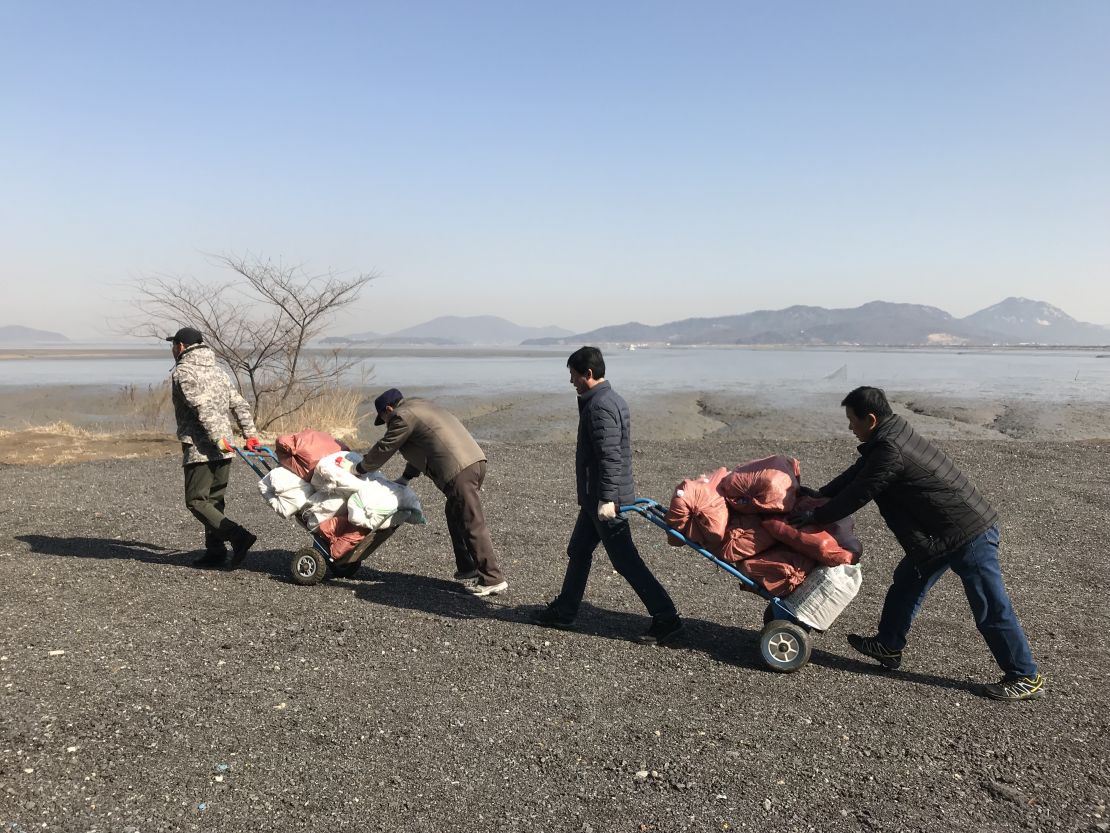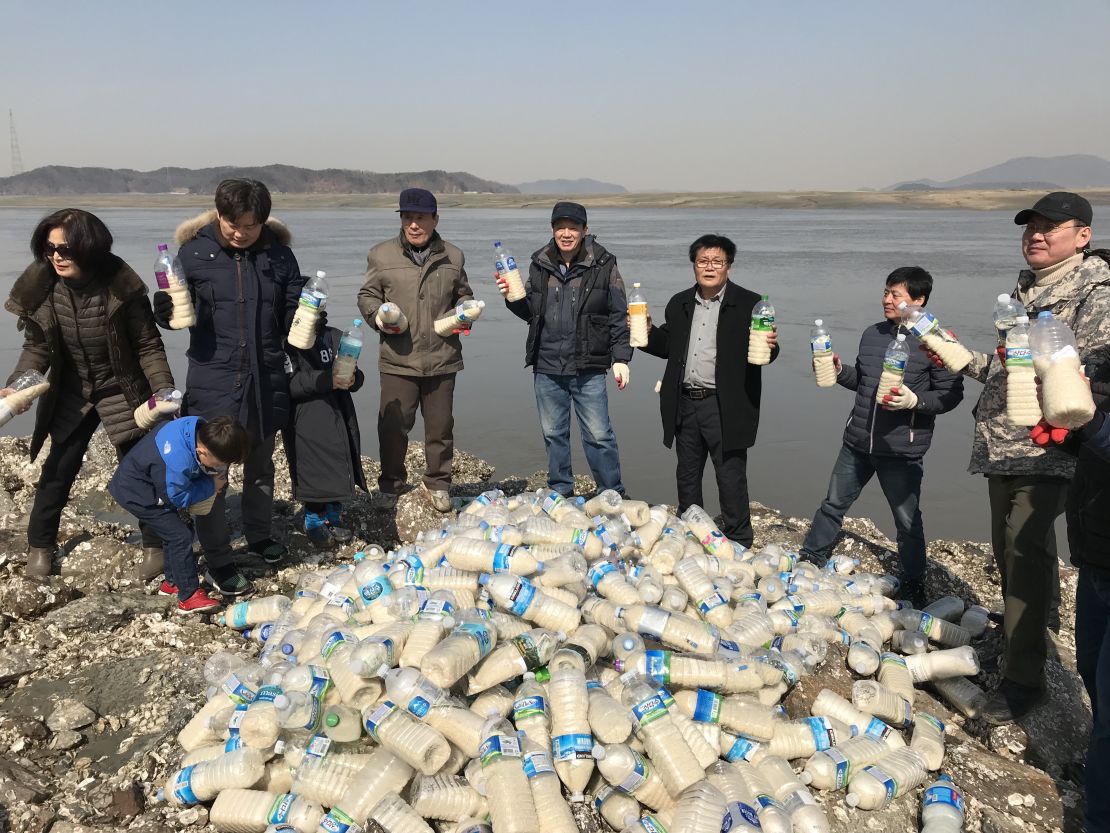When the activists arrive on the island on in a small truck and car, a dirt road was blocked by a piece of construction equipment.
So the men, all in their fifties, sixties, and seventies, simply unload their cargo and begin hauling heavy sacks on foot more than a half mile to the launch point.
This is as close as Jeong Gwang-il and his fellow volunteers can get to North Korea. Twice a month they come to this rocky jetty to deliver gifts for their poorer neighbors in the North.
The small group waits for the tide to change. They clasp their hands in prayer, and then they begin hurling hundreds of plastic bottles into the sea.

Each two-liter (0.5 gallon) bottle is an improvised care package, filled with a kilogram of uncooked white rice and a single US dollar bill, goods it would take the average North Korean 40 days to earn, the activists say.
The hope is that the rice could feed the 41% of the country that the United Nations believes is undernourished.
Also inside are medicine to kill parasites – doctors found worms in the stomach of a soldier who darted across the DMZ last year to defect – and a USB stick full of videos with information from the outside world. They hold information banned in the country meant “to wake up the North Korean people,” as Jeong puts it.
The last item is a note that says “God loves you.”
As we watch the flotilla of water bottles carried away by the tide toward North Korea, one of Jeong’s colleagues, a former North Korean military officer named Kim Yong-hwa, has much tougher words for the leadership in Pyongyang.
“Each one of these bottles of rice is a bullet against three generations of the Kim dictatorship,” he says, referring to North Korea’s ruling dynasty, currently headed by Kim Jong Un.
Activists, religious or not, have been informally smuggling food and information into North Korea for years.
Tim Peters, an American missionary who has lived for years in South Korea, uses small plastic bags full of seeds.
“It’s very important to recognize that North Korea is truly, based on UN reports … one of the great human rights disaster areas that we have in the world today, and included in that is food security,” he told CNN.
But activists like Peters, Jeong and Kim Yong-hwa face a new hurdle in their efforts: the South Korean government.
Peace on the Peninsula
When Kim Jong Un met South Korean President Moo Jae-in in late April, the historic occasion elicited emotional reactions from many South Koreans.
But activists like Peters and Jeong Gwang-il have conflicted feelings about the warming relations between Pyongyang and the outside world, and worry that the allegations of gross human rights abuses are being ignored.
Moon and Kim’s meeting ended with the two signing a declaration aimed at de-escalating tensions between the two Koreas, neighboring countries still technically at war.
The text outlined two examples of “hostile acts” that each side would cease to ease said tensions – removing loudspeakers that broadcast propaganda and stopping the distribution of leaflets along the border.
The agreement made no mention of civilians sending items into North Korea, but on May 4, South Korea’s Unification Ministry issued a statement asking civic groups to stop.
The next day, police surrounded another group of anti-North Korean activists near the DMZ, preventing them from floating balloons carrying propaganda leaflets across the border.
The activists distributed cell phone video showing that they had launched the balloons later at night. One carried a banner that said “Smash Kim Jong Un, the nuclear madman.”
Peters, the American missionary, takes a more nonviolent tone in his campaign.
“As the Bible says, if your enemy hungers, feed him,” Peters explains.
Cease hostile acts
Jeong says South Korean authorities recently contacted him asking him to stop sending bottled care packages to North Korea.
He says he refused and sent another batch floating towards the Northas recently as Monday
“South Korea is being played by Kim Jong Un’s scheme,” he argues.
“Stopping the information flow into North Korea is one way Kim maintains his control over North Korea … that’s why he asked South Korea to stop the propaganda speakers along the border.”
Each USB stick Jeong sends is loaded with videos. Some feature women in America doing show-and-tell demonstrations about how to drive cars or decorate bedrooms.

Also included is US President Trump’s speech last November to the South Korean National Assembly during which he announced “an estimated 100,000 North Koreans suffer in gulags, toiling in forced labor, and enduring torture, starvation, rape and murder on a constant basis.”
The North Korean government, for its part, bristles at this type of criticism, frequently denouncing what it calls “the imperialists’ human rights racket.”
Jeong met face to face with US President Donald Trump at the White House last February to tell him his story. But now, he’s concerned that Trump could ignore the cases he mentioned in his speech if it would lead to the denuclearization of North Korean.
“I’m very disappointed that human rights is not on the agenda of the summits,” says Jeong, adding that he was tortured while imprisoned in North Korea decades ago.
Standing on the jetty, the Jeong and the other activists watch the last bottles drift slowly out of sight.
They have no proof that their care packages ever reach ordinary North Koreans.
But they claim South Korean border guards have told them they saw North Korean soldiers and civilians scooping up rice-filled bottles along the shore.
“We are sending this without any conditions attached. We are sending these out of love,” says Kim Yong-ha, the former North Korean army officer.
It is a message of hope, he says. A message in a bottle.





